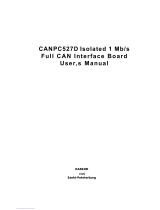
DAI16-4(FIT)GY
iii
Table of Contents
Check Your Package............................................................................................................................ i
Copyright ............................................................................................................................................ ii
Trademarks ......................................................................................................................................... ii
Table of Contents...............................................................................................................................iii
1. BEFORE USING THE PRODUCT 1
About the Module ............................................................................................................................... 1
Features ........................................................................................................................................ 1
Functions and control method by controller connected .............................................................. 2
Customer Support ............................................................................................................................... 4
Web Site....................................................................................................................................... 4
Limited One-Year Warranty............................................................................................................... 4
How to Obtain Service ....................................................................................................................... 4
Liability............................................................................................................................................... 4
Safety Precautions .............................................................................................................................. 5
Safety Information ....................................................................................................................... 5
Handling Precautions................................................................................................................... 6
Environment................................................................................................................................. 8
Inspection..................................................................................................................................... 8
Storage ......................................................................................................................................... 8
Disposal ....................................................................................................................................... 8
2. MODULE NOMENCLATURE AND SETTINGS 9
Nomenclature of Module Components .............................................................................................. 9
Setting a Device ID............................................................................................................................. 9
Setup Method............................................................................................................................... 9
Range Setting Switches .................................................................................................................... 10
Setup Method............................................................................................................................. 10
3. CONNECTING TO AN EXTERNAL DEVICE 11
Interface Connector .......................................................................................................................... 11
How to Connect an Interface Connector ................................................................................... 11
Signal Layout on the Interface Connector................................................................................. 12
Connecting an Analog Output Signal............................................................................................... 13
Connecting a Voltage Output .................................................................................................... 13
Connecting a Current Output..................................................................................................... 14
Fitting the Shield Cover............................................................................................................. 16





















